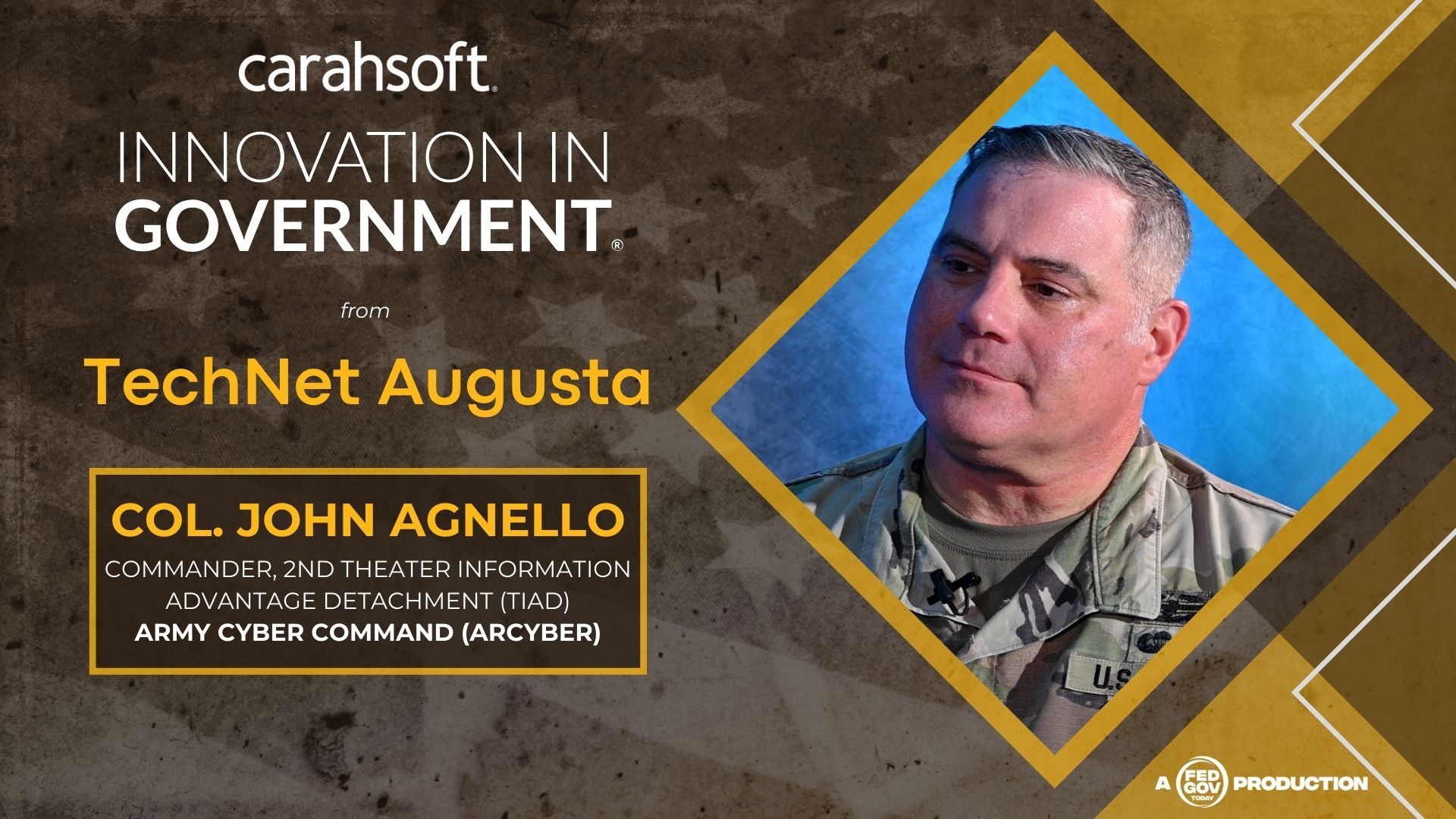Original broadcast 9/17/25
Presented by Carahsoft
At TechNet Augusta in Augusta, Georgia, Innovation in Government gathered military and industry leaders to discuss the technologies, strategies, and operational changes shaping the future of Army cyber, electronic warfare, and multi-domain operations. Conversations spanned AI, zero trust, edge computing, electromagnetic spectrum operations, and the integration of cyber and information advantage into warfighting. Together, these insights provide a comprehensive look at how the Army and its partners are adapting to a contested information environment and accelerating the delivery of capabilities to the field.
Securing AI in Defense
 Steve Jacyna, Director at Carahsoft, emphasized the responsible deployment of AI in defense environments. He outlined three central pillars: treating AI identity like a human identity with strict authentication and zero trust policies, ensuring humans remain in the decision loop, and embedding ethical frameworks to prevent misuse in sensitive military contexts. He also underscored the importance of building a cybersecurity workforce through education, training, and partnerships, including early exposure in K–12 and public–private exchange programs.
Steve Jacyna, Director at Carahsoft, emphasized the responsible deployment of AI in defense environments. He outlined three central pillars: treating AI identity like a human identity with strict authentication and zero trust policies, ensuring humans remain in the decision loop, and embedding ethical frameworks to prevent misuse in sensitive military contexts. He also underscored the importance of building a cybersecurity workforce through education, training, and partnerships, including early exposure in K–12 and public–private exchange programs.
Key Takeaways
-
Identity management and zero trust are essential for securing AI systems.
-
Human oversight must remain central in military decision-making with AI.
-
Building a strong cyber workforce requires early education, higher-ed alignment, and public–private exchanges.
Information Advantage Across the Competition Continuum
 Colonel John Agnello, Commander of the 2nd Theater Information Advantage Detachment at Army Cyber Command, described how the Army’s detachments integrate cyber, electronic warfare, psychological operations, civil affairs, and public affairs to give commanders a clear view of the information environment. By supporting operations across competition, crisis, and conflict, TIADs enable faster, more informed decisions. He shared lessons from Pacific and European exercises, highlighting the need for visualization tools, diverse skill sets, and technologies to interpret and act in contested information spaces.
Colonel John Agnello, Commander of the 2nd Theater Information Advantage Detachment at Army Cyber Command, described how the Army’s detachments integrate cyber, electronic warfare, psychological operations, civil affairs, and public affairs to give commanders a clear view of the information environment. By supporting operations across competition, crisis, and conflict, TIADs enable faster, more informed decisions. He shared lessons from Pacific and European exercises, highlighting the need for visualization tools, diverse skill sets, and technologies to interpret and act in contested information spaces.
Key Takeaways
-
TIADs converge multiple information disciplines to shape operations across competition, crisis, and conflict.
-
Recent exercises highlight the importance of visualization and analysis of the information space.
-
Missions and requirements vary by theater, demanding flexible skills and technologies.
Trusted Data at the Edge for Multi-Domain Operations
 Von Gardiner, Director of DoD and Distinguished Technologist at Hewlett Packard Enterprise, emphasized integrating trusted data and decision-making across all domains—air, land, sea, space, and cyber. He stressed open standards, interoperability, and coalition sharing, noting that speed and trust will define success. He also pointed to the migration of data and compute to the edge, enabling forces to operate effectively in contested or disconnected environments.
Von Gardiner, Director of DoD and Distinguished Technologist at Hewlett Packard Enterprise, emphasized integrating trusted data and decision-making across all domains—air, land, sea, space, and cyber. He stressed open standards, interoperability, and coalition sharing, noting that speed and trust will define success. He also pointed to the migration of data and compute to the edge, enabling forces to operate effectively in contested or disconnected environments.
Key Takeaways
-
Trusted, integrated data is critical for multi-domain decision-making.
-
Open standards and interoperability enable coalition and joint operations.
-
Edge computing ensures resilience in contested and disconnected environments.
Winning the AI Race
 Tom Stockmeyer, Managing Director for Government and Critical Infrastructure at Cyware, described the AI race as central to future military power projection and defense. He argued that U.S. success depends on unleashing American innovation with minimal regulation, while carefully testing and auditing AI deployments. He outlined AI’s dual role in offensive and defensive operations, from automating military actions to enhancing SOC effectiveness, and forecast a future of “collective defense” where AI coordinates weapons platforms and protects critical infrastructure.
Tom Stockmeyer, Managing Director for Government and Critical Infrastructure at Cyware, described the AI race as central to future military power projection and defense. He argued that U.S. success depends on unleashing American innovation with minimal regulation, while carefully testing and auditing AI deployments. He outlined AI’s dual role in offensive and defensive operations, from automating military actions to enhancing SOC effectiveness, and forecast a future of “collective defense” where AI coordinates weapons platforms and protects critical infrastructure.
Key Takeaways
-
The U.S. must lead the AI race to maintain security dominance.
-
AI has transformative roles in both offensive and defensive operations.
-
Success requires iterative testing, stakeholder involvement, and strong auditing.
Lessons from Ukraine: Data, AI, and Electromagnetic Warfare
 David May, Senior Cyber Intelligence Advisor at the U.S. Army Cyber Center of Excellence, and CW5 Travis Ysen, Senior Technology Advisor at U.S. Army Training and Doctrine Command, explained how Ukraine’s battlefield underscores the decisive role of electromagnetic warfare. They stressed rapid system reprogramming, data interoperability, and edge computing to keep pace with adversary adaptations. They highlighted AI’s role in accelerating reprogramming, anomaly detection, and signal characterization, while noting challenges around data quality, trust, and talent acquisition, and called for a “trust but verify” approach to AI.
David May, Senior Cyber Intelligence Advisor at the U.S. Army Cyber Center of Excellence, and CW5 Travis Ysen, Senior Technology Advisor at U.S. Army Training and Doctrine Command, explained how Ukraine’s battlefield underscores the decisive role of electromagnetic warfare. They stressed rapid system reprogramming, data interoperability, and edge computing to keep pace with adversary adaptations. They highlighted AI’s role in accelerating reprogramming, anomaly detection, and signal characterization, while noting challenges around data quality, trust, and talent acquisition, and called for a “trust but verify” approach to AI.
 Key Takeaways
Key Takeaways
-
Electromagnetic warfare is rapidly evolving, requiring fast reprogramming and interoperability.
-
AI will accelerate signal analysis and reprogramming but must be trusted and verified.
-
Edge computing and refined data flows are critical to managing EMS operations at scale.
Elevating Non-Kinetic Effects to Kinetic Reliability
 Tom Afferton, President of the Cyber Mission Sector at Peraton, discussed bringing cyber, electronic warfare, and information operations up to the same level of reliability as kinetic effects. He emphasized strengthening data connectivity, cross-domain solutions, and operator-first design, along with AI-enabled tools to understand and shape the information environment under the principle “mission first, ethics always.” Collaboration among industry, operators, and academia is central to delivering trusted, intuitive solutions.
Tom Afferton, President of the Cyber Mission Sector at Peraton, discussed bringing cyber, electronic warfare, and information operations up to the same level of reliability as kinetic effects. He emphasized strengthening data connectivity, cross-domain solutions, and operator-first design, along with AI-enabled tools to understand and shape the information environment under the principle “mission first, ethics always.” Collaboration among industry, operators, and academia is central to delivering trusted, intuitive solutions.
Key Takeaways
-
Non-kinetic effects must achieve reliability comparable to kinetic operations.
-
Data provenance and edge-to-edge connectivity are vital for MDO success.
- Human-machine teaming and operator-first design ensure effective AI integration.
Accelerating Electromagnetic Spectrum Superiority
 Col. Scott Schaffer, Project Manager, Electronic Warfare & Cyber, PEO IEW&S explained how the Army is driving faster
Col. Scott Schaffer, Project Manager, Electronic Warfare & Cyber, PEO IEW&S explained how the Army is driving faster
delivery of electronic warfare and cyber capabilities to the field. By emphasizing rapid prototyping, soldier feedback, and flexible acquisition methods, his team is shortening timelines and ensuring systems are operationally relevant. He also highlighted the role of agile funding, training, and cultural change in building and sustaining spectrum dominance.
Key Takeaways:
-
-
Rapid prototyping and soldier involvement accelerate fielding of new systems.
-
Flexible acquisition tools such as OTAs and agile funding enable adaptability.
-
Training and culture shifts are essential to ensure soldiers can employ new capabilities effectively.
-
Zero Trust and Agility at the Tactical Edge
 Hansang Bae, Public Sector CTO at Zscaler Gov Solutions, explained why information agility is now as important as “beans and bullets.” In a true zero trust architecture, any available network—even commercial or adversary infrastructure—can be treated as commodity transport. He stressed local data presence, edge-to-edge exchange, and pre-loaded mission data for contested environments, and warned against AI models training on AI-generated content without clear metadata tagging.
Hansang Bae, Public Sector CTO at Zscaler Gov Solutions, explained why information agility is now as important as “beans and bullets.” In a true zero trust architecture, any available network—even commercial or adversary infrastructure—can be treated as commodity transport. He stressed local data presence, edge-to-edge exchange, and pre-loaded mission data for contested environments, and warned against AI models training on AI-generated content without clear metadata tagging.
Key Takeaways
-
Zero trust enables secure use of any available network for rapid comms.
-
Localized data and edge-to-edge sharing are vital in contested operations.
-
Careful data hygiene is needed to prevent AI model degradation.



